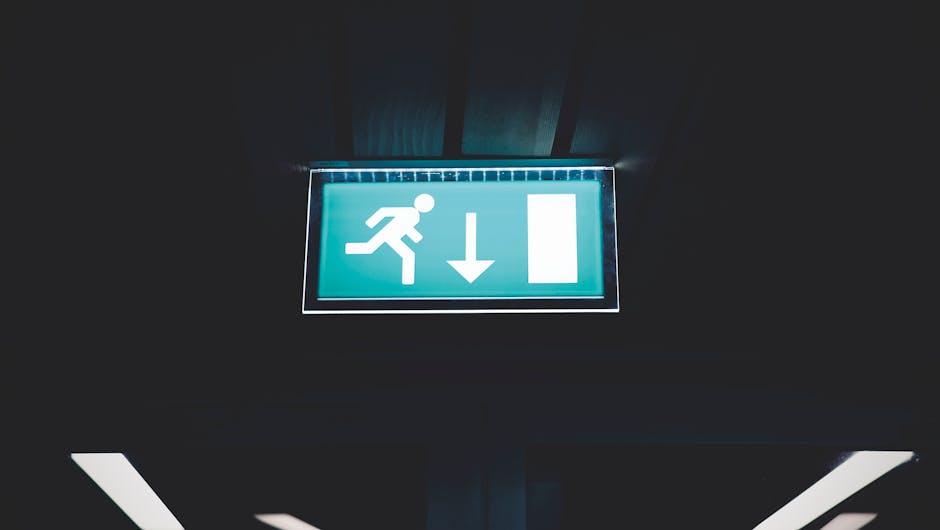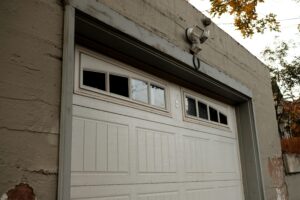When seconds count and safety is on the line, the design of emergency exits can mean the difference between chaos and calm. In Minnesota, the regulations surrounding panic bars and emergency exits are more than just building codes-they are lifelines engineered to protect lives in moments of crisis. Understanding these legal requirements isn’t merely a matter of compliance; it’s a commitment to safeguarding the public. This article explores the essential standards governing panic hardware and emergency egress in Minnesota, illuminating the critical role they play in emergency preparedness and building safety.
Table of Contents
- Understanding Minnesota’s Legal Landscape for Panic Bars and Emergency Exits
- Key Safety Standards Governing Panic Bar Installations in Public and Commercial Buildings
- Ensuring Compliance through Regular Inspections and Maintenance Practices
- Best Practices for Emergency Exit Signage and Accessibility Requirements
- Recommendations for Building Owners to Meet and Exceed Safety Regulations
- Q&A
- Insights and Conclusions

Understanding Minnesota’s Legal Landscape for Panic Bars and Emergency Exits
In Minnesota, the requirements for panic bars and emergency exits are governed by a combination of state building codes and fire safety regulations designed to prioritize occupant safety. Businesses and public buildings must install panic bars on exit doors where rapid egress is necessary, especially in assembly areas, schools, and healthcare facilities. These devices must provide an easy-to-operate, single-motion release mechanism that allows door operation under pressure, preventing bottlenecks and ensuring swift evacuation during emergencies. Additionally, emergency exits must remain unobstructed and clearly marked, complying with standards set by the Minnesota State Building Code (MSBC) and the National Fire Protection Association (NFPA) 101 Life Safety Code.
To maintain legal compliance, property owners should also consider the specific installation criteria, including:
- Height and placement: Panic bars must be mounted at a height between 34 and 48 inches from the floor to ensure accessibility.
- Door type compatibility: Devices are required on doors swinging in the direction of egress in high-occupancy buildings.
- Inspection and maintenance: Regular checks must be conducted to ensure panic bars function correctly without any mechanical hindrances.
| Requirement | Key Standard | Implication |
|---|---|---|
| Panic Bar Installation | MSBC §1023 & NFPA 101 | Rapid door release mandatory |
| Signage | MN Fire Code | Visible exit signage required |
| Accessibility | ADA Standards | Accessible height and operation |

Key Safety Standards Governing Panic Bar Installations in Public and Commercial Buildings
In Minnesota, ensuring the proper installation of panic bars on emergency exits is governed by a range of safety regulations aimed at facilitating quick, unobstructed egress during emergencies. These regulations stem primarily from the Minnesota State Building Code and align with national standards such as the International Building Code (IBC) and the National Fire Protection Association (NFPA) 101 Life Safety Code. These standards mandate that panic hardware must be installed on exit doors in commercial buildings and public venues where large groups gather, such as theaters, schools, and shopping centers, to prevent delays in emergency evacuations.
Key requirements include:
- Minimum force: Panic bars must operate with minimal force to ensure easy opening under pressure.
- Clear signage: Exit doors equipped with panic bars must be clearly marked with illuminated “EXIT” signs.
- Accessibility: Doors must be usable by all occupants, including those with disabilities, in compliance with the Americans with Disabilities Act (ADA).
- Maintenance: Regular inspections and immediate repairs of panic bars are required to guarantee operational readiness.
| Standard | Focus Area | Requirement |
|---|---|---|
| IBC 1013 | Panic Hardware Installation | Automatic unlatching under 15 pounds of force |
| NFPA 101 | Life Safety | Emergency exit access and egress |
| Minnesota Building Code | State Compliance | Mandatory panic bar in public buildings over 50 occupants |

Ensuring Compliance through Regular Inspections and Maintenance Practices
Maintaining the functionality and reliability of panic bars and emergency exits requires a disciplined schedule of inspections and upkeep. Experts recommend conducting monthly visual assessments to identify any physical damage, obstruction, or wear that could hinder quick evacuation. Documenting each check ensures that building owners and managers can demonstrate compliance with Minnesota fire and safety codes. Additionally, testing the mechanical operation of panic bars under normal conditions is crucial to guarantee they release promptly during an emergency.
To optimize maintenance efforts, facilities should incorporate the following best practices:
- Regular lubrication of moving parts to prevent rust and stiffness.
- Clear labeling and illumination around emergency exits for easy identification.
- Immediate repair or replacement of malfunctioning hardware.
- Staff training to recognize potential issues and report them promptly.
| Inspection Task | Frequency | Responsible Party |
|---|---|---|
| Visual Door Condition Check | Monthly | Facility Manager |
| Panic Bar Function Test | Quarterly | Safety Officer |
| Emergency Exit Clearance | Weekly | Maintenance Staff |
| Documentation Review | Annually | Compliance Auditor |

Best Practices for Emergency Exit Signage and Accessibility Requirements
Ensuring emergency exit signage meets both visibility and accessibility standards is a cornerstone of safety compliance in Minnesota. Signs must be installed at eye level and use high-contrast colors, typically white text on a red or green background, to ensure quick recognition even under low-light conditions. Additionally, the text should be clear and concise, avoiding any ambiguity that could delay evacuation. Employing pictograms alongside text enhances comprehension for non-English speakers and individuals with cognitive disabilities, promoting universal accessibility. Proper illumination-either through photoluminescent materials or strategically placed lighting-is crucial to maintain sign effectiveness during power outages or smoky environments.
Accessibility for all building occupants means considering more than just signage. Emergency exit routes must be free of obstacles and wide enough to accommodate wheelchairs, with doors equipped with panic bars that require minimal force to operate. To assist visually impaired individuals, tactile surfaces and auditory indicators near exits guide users safely toward egress points. The following table summarizes key criteria for compliant emergency signage and access:
| Requirement | Specification | Purpose |
|---|---|---|
| Sign Height | 60-72 inches above floor | Optimal visibility for all users |
| Contrast & Colors | Bright colors with high contrast | Enhanced readability in various conditions |
| Illumination | Photoluminescent or LED lighting | Visibility during power failure |
| Accessibility Features | Tactile & auditory cues | Assist visually impaired evacuees |
| Exit Width | Minimum 32 inches clear width | Wheelchair access and flow |

Recommendations for Building Owners to Meet and Exceed Safety Regulations
Building owners in Minnesota aiming to align with and surpass safety regulations must prioritize the strategic installation and maintenance of panic bars and emergency exits. These devices are not only crucial for compliance but serve as life-saving mechanisms during emergencies. The first step involves conducting a comprehensive audit of all exits to ensure each is equipped with hardware that meets the Minnesota State Fire Code requirements. Regular inspections should be scheduled to promptly address any wear and tear or functional failures. Key considerations include:
- Installing panic bars that allow easy egress without special knowledge or tools.
- Ensuring emergency exits are clearly marked and unobstructed at all times.
- Maintaining doors and hardware to operate smoothly under all conditions.
- Training staff to understand the importance of keeping exits accessible and functional.
To help visualize compliance priorities, consider the following simple table showcasing recommended panic bar features and signs of potential safety risks:
| Recommended Features | Potential Safety Risks |
|---|---|
| Certified panic hardware | Stiff or jammed bars |
| Illuminated exit signage | Blocked or locked emergency exits |
| Durable and vandal-resistant materials | Missing or damaged exit signs |
Through diligent attention to these details, building owners will not only meet mandatory legal requirements but also demonstrate a commitment to occupant safety that goes beyond the minimum standards. This proactive approach can greatly reduce liability risks, enhance emergency preparedness, and ultimately save lives.
Q&A
Q&A: Panic Bars & Emergency Exits – Legal Requirements for Minnesota
Q1: What are panic bars, and why are they important in emergency exits?
A1: Panic bars, also known as crash bars or push bars, are horizontal bars installed on exit doors to allow quick and easy egress during emergencies. They are crucial because they enable people to exit a building swiftly without fumbling with locks, which can save lives during fires, power outages, or other urgent situations.
Q2: Does Minnesota law require panic bars on all emergency exit doors?
A2: Minnesota follows the International Building Code (IBC) and Life Safety Code (NFPA 101), which generally require panic hardware on exit doors in buildings with high occupant loads or specific uses, such as schools, theaters, and places of assembly. Not every emergency exit must have a panic bar, but when required, the hardware must comply with code specifications.
Q3: What kinds of buildings in Minnesota must install panic bars on emergency exits?
A3: Buildings classified as places of assembly (like theaters, auditoriums, stadiums), educational facilities, healthcare institutions, and certain commercial buildings with large occupancies typically must have panic bars on emergency exits. The exact requirements depend on building use, occupant load, and door function.
Q4: Are there specific technical requirements for panic bars in Minnesota?
A4: Yes. Minnesota mandates that panic bars be operable with a single motion and must not require tight grasping, pinching, or twisting of the wrist. They must unlock the door immediately upon pressure and meet ANSI/BHMA and UL standards for fire resistance and durability.
Q5: How do emergency exit requirements in Minnesota address fire safety?
A5: Minnesota’s codes require emergency exits to provide safe, unobstructed, and clearly marked egress routes. Doors with panic bars must also comply with fire door ratings and maintain fire separation integrity. This ensures that in the event of a fire, occupants can exit quickly without compromising the building’s fire containment.
Q6: What happens if a Minnesota building does not comply with panic bar or emergency exit regulations?
A6: Non-compliance can result in fines, orders to retrofit or upgrade hardware, and potential closure of the premises until code compliance is met. More importantly, it poses serious safety risks to occupants, possibly leading to legal liability if injuries occur during an emergency.
Q7: Can property owners in Minnesota customize emergency exit doors with panic bars?
A7: Yes, but any customization must still meet or exceed the performance standards set by state and national codes. The design cannot compromise functionality or safety. Consulting with fire safety professionals and local code officials before installation is highly recommended.
Q8: How does Minnesota handle inspections for panic bars and emergency exits?
A8: Local fire marshals and building inspectors routinely check commercial and public buildings to ensure compliance with egress requirements, including the presence and function of panic bars on emergency exits. Regular maintenance and testing are also expected to keep exit hardware operational.
This Q&A provides a foundational understanding of panic bar and emergency exit regulations in Minnesota. For precise directives, always refer to the latest Minnesota State Building Code and consult local authorities.
Insights and Conclusions
In the fast-paced world of safety regulations, understanding the legal requirements for panic bars and emergency exits in Minnesota is not just a matter of compliance-it’s a commitment to safeguarding lives. From ensuring easy, unobstructed egress to meeting state-specific codes, every detail counts in creating a secure environment for all. By staying informed and proactive, building owners and managers can navigate these regulations confidently, turning potential risks into well-managed safety solutions. After all, when it comes to emergency exits, the path to safety should never be a question-it should be the law.




